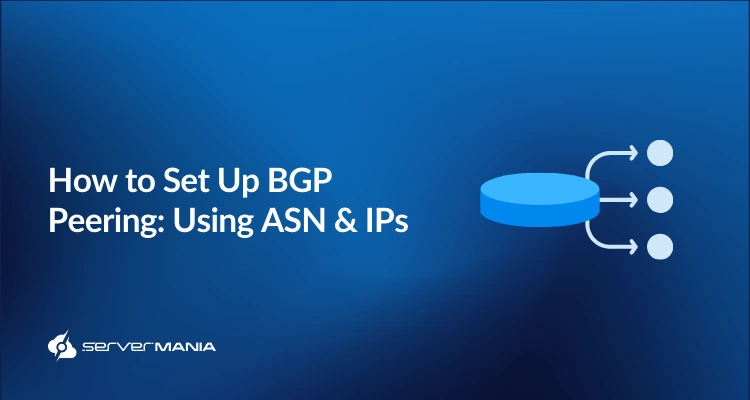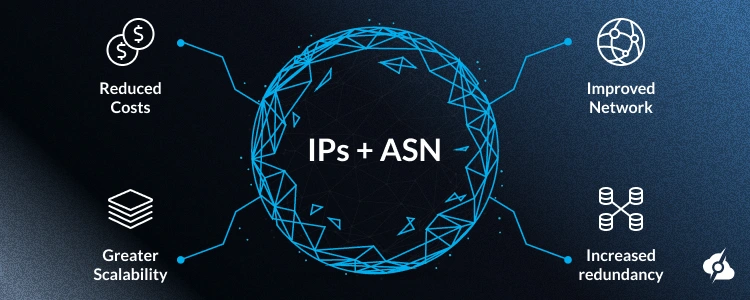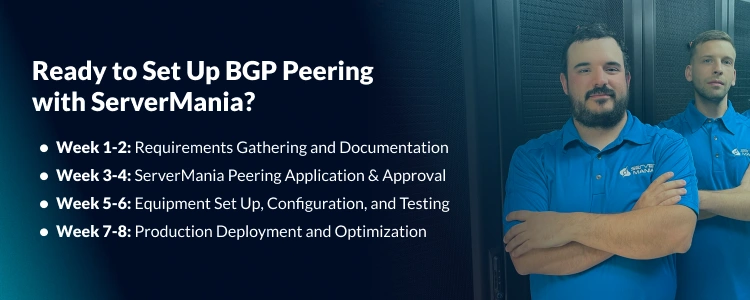How to Set Up BGP Peering with ServerMania Using Your Own ASN and IPs

If you already own an IP Address Space and an Autonomous System Number (ASN), ServerMania can provide you with Border Gateway Protocol (BGP) peering, allowing you to control the announcement of your prefixes directly over our network.
ServerMania’s high-performance servers and global network, spanning across 8 data centers with direct peering to over 100 networks, allow you to bring your own IPs, maintain consistent addressing across providers, and manage how your traffic flows.
A typical client observes around 20–40% reduced lag and 30–50% cost savings on international traffic, while our ANS 25369 can guarantee 99.998% uptime.
In this quick guide, we’ll walk you through how BGP peering with ServerMania works, what you will need to get started, and the step-by-step process to announce your own IPs through our infrastructure.
The Advantage of Using Your Own IPs and ASN
When you run your own autonomous system number (ASN), you acquire permanent presence in the Internet Assigned Numbers Authority and routing table.
Here are some of the standout advantages:
| Advantage | What It Means | Technical Benefit |
|---|---|---|
| Control of Addresses | Your IPs remain tied to your autonomous system, not a third party. | Easily move between providers or data centers without renumbering or reconfiguring your BGP sessions. |
| Multihoming & Redundancy | Peer with multiple networks simultaneously. | Optimizes the uptime by providing multiple BGP peers that exchange routing information and maintain your reachability. |
| Performance Optimization | Influence how inbound and outbound traffic flows by manipulating path attributes. | Use routing policies, next-hop IP address manipulation, and path attributes to optimize traffic paths. |
| Brand & Network Reputation Protection | Maintain consistent IP ownership for your ASN. | Prevents IP reallocation by third parties, protecting your network identity and improving trust with peers and services. |

BGP Configuration Prerequisites
Before you establish Border Gateway Protocol (BGP) peering with ServerMania, you’ll need to ensure the following:
- Public ASN: It’s mandatory to have your own autonomous system number (ASN), registered with the Regional Internet Registry (RIR) and recognized by the Internet Assigned Numbers Authority.
- IP Allocations: It’s critical to own a minimum of /24 IPv4 or /48 IPv6, to be routable and accepted by the peers in the BGP table.
- WHOIS Accuracy: You need to ensure that your contacts (e.g, contact information) are updated in the RIR database, and your address usage classification matches the correct operational intent.
- RPKI Setup: Lastly, you must configure the Route Origin Authorization (ROA), which is strongly recommended to secure your prefixes and prevent route theft.
Note: If you already have an autonomous system number (ASN) but don’t yet own an address range, ServerMania offers IPv4 Leasing.
How the BGP Routing Process Works with ServerMania
Here’s a simplified look at how the process works:
- You: Operate your own ASN and have IP space assigned to it.
- ServerMania: Establishes a BGP session with your router or server.
- Your IPs are announced: We propagate your prefixes to the global internet through our network.
- Routing control: You determine what routes to advertise and how to handle inbound/outbound traffic.
ServerMania’s BGP Network Infrastructure
Global Presence:
- 10+ data centers across North America and Europe
- Direct peering with content networks and cloud providers
- Tier-1 upstreams, including GTT, NTT, Cogent, and Zayo
- Internet Exchange Points participation at major IXPs
Network Performance:
- Multi-gigabit backbone with redundant fiber paths
- 99.9% uptime SLA with proactive network monitoring
- <50ms latency to major internet hubs globally
- 24/7 Network Operations Center with expert BGP support
Peering Capabilities:
- Settlement-free peering for qualifying networks
- Private Network Interconnect options available
- Flexible routing policies supporting customer requirements
- BGP communities for granular traffic engineering
Step-by-Step: Setting Up BGP Peering with ServerMania
When you’re ready to set up and configure BGP with ServerMania, you should follow this simple step-by-step tutorial that walks you through the entire process:
1. Request a BGP Session
To initiate the process of BPG peering with ServerMania, you need to begin by getting in touch with us, either via submitting a ticket, live chat, or by calling us directly.
Before you contact us, make sure you can clearly outline the following:
- Your Autonomous System Number (ASN): As mentioned, this is the unique identifier for your network, and it is mandatory to establish a proper BGP session with ServerMania’s ASN 25369.
- Your Public IP Prefixes: A clear list of all IPv4 and IPv6 prefixes you intend to announce through BGP, as well as your BGP version your router will use.
- Desired Peering IPs: You also need to outline the local router interface IPs that you would like to use for the BGP neighbor configuration, commonly through your loopback interface.
- Routing Policy Notes: Last, but not least, you must include any preferences for communities, Multi-Exit Discriminator (MED), or inbound/outbound routing policies.
2. Configure Router or Server
Once your peering connection is approved, you’ll need to enter a configuration mode on your router or server to establish peering with ServerMania using the Border Gateway Protocol routing protocol.
This involves specifying your autonomous system number, network ID, and the neighbor’s IP address while defining which connected network prefixes to announce in the BGP process. This allows your router to exchange routing data with different autonomous systems for proper multihoming.
Also, if applicable, configure an internal BGP (iBGP) to propagate routes between routers within your autonomous system. You can also implement BGP route aggregation to combine smaller prefixes into a single announcement, reducing table size and simplifying route propagation.
Here’s an example using FRRouting (FRR):
router bgp 67890
bgp router-id 203.0.113.1
neighbor 198.51.100.1 remote-as 12345
neighbor 198.51.100.1 password myBGPpassword
network 203.0.113.0/24Here’s an example using BIRD:
protocol bgp ServerMania {
local as 67890;
neighbor 198.51.100.1 as 12345;
password "myBGPpassword";
export where net = 203.0.113.0/24;
}Here’s an example using Cisco IOS:
router bgp 67890
bgp router-id 203.0.113.1
bgp log-neighbor-changes
neighbor 198.51.100.1 remote-as 25369
neighbor 198.51.100.1 description "ServerMania BGP Peering"
neighbor 198.51.100.1 password myBGPpassword
neighbor 198.51.100.1 maximum-prefix 1000000 restart 5
address-family ipv4 unicast
neighbor 198.51.100.1 activate
neighbor 198.51.100.1 soft-reconfiguration inbound
neighbor 198.51.100.1 route-map SM-OUT out
network 203.0.113.0 mask 255.255.255.0
exit-address-family
! Security and filtering
ip prefix-list MY-PREFIXES permit 203.0.113.0/24
route-map SM-OUT permit 10
match ip address prefix-list MY-PREFIXES3. Apply Prefix Filtering
Set a maximum prefix limit and filter routes to ensure only your intended ranges are announced. This protects against accidental leaks and session drops.
Here’s an example using FRRouting (FRR):
router bgp 67890
neighbor 198.51.100.1 maximum-prefix 50
neighbor 198.51.100.1 prefix-list MY-PREFIXES out
ip prefix-list MY-PREFIXES seq 5 permit 203.0.113.0/24Here’s an example using BIRD:
filter MY-PREFIXES {
if net = 203.0.113.0/24 then accept;
else reject;
}
protocol bgp ServerMania {
local as 67890;
neighbor 198.51.100.1 as 12345;
export filter MY-PREFIXES;
}Here’s an example using Cisco IOS:
ip prefix-list MY-PREFIXES seq 5 permit 203.0.113.0/24
router bgp 67890
neighbor 198.51.100.1 remote-as 12345
neighbor 198.51.100.1 maximum-prefix 50
neighbor 198.51.100.1 prefix-list MY-PREFIXES out4. Test Your Session
To test whether your BGP is successful, you should run commands such as:
show ip bgp summary
show ip bgp neighborsYou can also use “route refresh” to request updated routing information from your BGP neighbor without resetting the session. Also, make sure your BGP neighbor IP address supports refresh capability, so updated routing information can be requested without resetting the session.
💡Quick Tip: To check whether your prefixes are available, go to bgp.he.net and search for your ASN or IP prefix to reveal a detailed page for your autonomous system.
5. It’s Time to Go Live
Once your BGP speaker is established and validated, ServerMania will begin announcing your network prefixes, allowing your autonomous system number (ASN) to participate in the global routing process. Your BGP router exchanges network layer reachability information with ServerMania’s peer router, updating the BGP table and BGP databases with the intended routes.
Monitor the session using IP summary or BGP status commands to confirm the BGP neighbor is active, the prefixes are correctly advertised, and outbound policies are applied. With your routing process live, your network benefits from multihoming, optimized traffic paths, and full control over routing between different autonomous systems.
Performance Optimization and Monitoring
When the Border Gateway Protocol BPG peering has been established, it’s critical to continue monitoring the session and check for any optimization opportunities.
ServerMania supports standard BGP communities for granular traffic engineering:
- 25369:100 – Set local preference to 100
- 25369:200 – Set local preference to 200
- 25369:300 – Set local preference to 300
- 25369:999 – Blackhole traffic (DDoS mitigation)
For monitoring and diagnostics, use commands such as:
show ip bgp neighbors 198.51.100.1 This will help you verify the session status!
In addition, try:
show ip bgp 203.0.113.0/24 or,
show ip route bgpThis will help you confirm advertised routes!
Troubleshooting Tips & Debugging
Session won’t establish?
- #1 – Verify the autonomous system number (ASN)
- #2 – Check firewall rules and port 179 access.
- #3 – Ensure that the MD5 password matches.
The prefixes are invisible?
- Check and confirm prefix length (/24 minimum for IPv4, /48 for IPv6).
- Check and verify the RPKI status.
- Check export filters on your side.
⚠️ Advanced Border Gateway Protocol Diagnostics: (use cautiously)
BGP Debugging:
debug ip bgp 198.51.100.1 events
debug ip bgp 198.51.100.1 updatesRoute Analysis:
show ip bgp regexp 25369
show ip bgp community 25369:100Connectivity Testing:
ping 198.51.100.1 source 203.0.113.1
traceroute 198.51.100.1See Also: What is Smart Routing?
Getting Started:

Ready to peer with ServerMania?
Contact our team with your Autonomous System Number (ASN) and prefix details, and we’ll guide you through the setup.
Was this page helpful?

